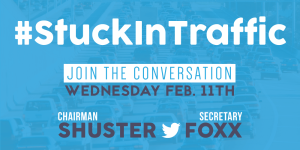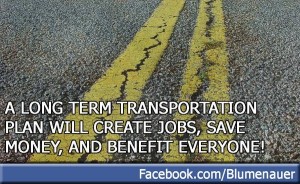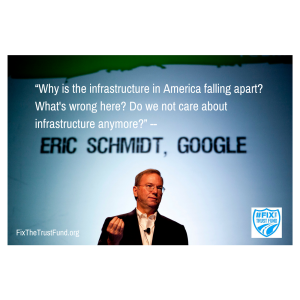This Week in Infrastructure: Infrastructure Won't Fix Itself
February 13th, 2015 | By: Olivia Wolfertz
It is not a news flash that America’s infrastructure needs serious attention and investment. In light of increased attention to our nation’s surface transportation needs, many states are proposing increasing the gas tax to fund transportation. In addition, there has been an uptick in the number of news stories highlighting the need to be more strategic in the way we fund infrastructure. After chunks of concrete fell this week from a bridge on the DC Beltway in Maryland onto a moving vehicle, Manager of Public and Government Affairs at AAA Mid-Atlantic said “this is yet another reminder of why transportation funding in Maryland is so critically needed.” This incident prompted Transportation Secretary Anthony Foxx to underscore the necessity of providing funding to maintain and repair the nation’s bridges. Pennsylvania’s bridges have also received media attention lately, with 22 percent of the state’s bridges classified as structurally deficient, making it the highest percentage in the country. In an effort to fund their aging transportation infrastructure, more and more states are considering gas tax increases. Iowa is proposing a 10-cent gas tax hike that would generate close to $215 million a year for Iowa’s road system. Utah is recommending a bill to raise diesel fuel by 10 cents per gallon for road and bridge maintenance. Georgia is considering a $1 billion transportation funding plan that would steer gasoline tax revenue toward asphalt and concrete repairs. Though increasing state-level gas taxes is a step in the right direction, long-term, sustainable federal funding is critical to restore the nation’s infrastructure, as the states need the federal government to continue being a trusted partner in transportation projects. Transportation Secretary Anthony Foxx told Congress this week that temporary funding patches do not provide enough money for states and local governments to finance “badly needed long-range construction projects,” noting that the Obama administration has proposed a measure to spend $478 billion over the next six years. As states continue to make decisions with limited budgets, one tool that can help them make the most of the investment is life cycle cost analysis. Vox recapped a study by Smart Growth America, reaching similar conclusions to ASCE’s Maximizing the Value of Investment Using Life Cycle Cost Analysis report. Increased investment is essential in maintaining our transportation system in a state of good repair. By using effective planning tools such as life cycle cost analysis coupled with an increased investment, America will be better equipped to modernize its transportation system. Regardless of states’ efforts to fund transportation infrastructure, the Highway Trust Fund is headed towards insolvency in a matter of months. If there is no fix it will be detrimental to every state and our economy It’s imperative that members of Congress work together to pass legislation that will provide a sustainable, long-term funding solution to #Fix-the-Trust Fund.Tags: bridges, gas tax, highway trust fund, infrastructure
1 Comment »
Chime in on Wednesday to Fix the Trust Fund
February 9th, 2015 | By: Becky Moylan
As Congress continues the debate on the best way to #FixTheTrustFund and modernize America’s roads, bridges, and transit, USDOT Sec. Foxx and Transportation & Infrastructure Chairman Bill Shuster are heading to Twitter for a bipartisan “townhall” to discuss surface transportation. The town hall, a first of its kind, will be Wednesday, Feb. 11 after Sec. Foxx concludes his testimony in from of the U.S. House of Representatives’ Transportation & Infrastructure Committee, around 12 p.m. ET. Now it’s up to you to ask your questions about transportation investment and voice your support for a long-term funding solution. To get the conversation rolling, here are some key facts from the 2013 Report Card for America’s Infrastructure that would make great tweeting material. To join in the conversation, use #StuckInTraffic anytime between now and Wednesday.
Now it’s up to you to ask your questions about transportation investment and voice your support for a long-term funding solution. To get the conversation rolling, here are some key facts from the 2013 Report Card for America’s Infrastructure that would make great tweeting material. To join in the conversation, use #StuckInTraffic anytime between now and Wednesday.
- One in nine U.S. bridges is structurally deficient.
- 45% of Americans don’t have access to public transportation.
- 42% of major urban highways are congested, costing the economy $101B a year.
- 32% of America’s major roads are in poor or mediocre condition.
- Americans spend nearly a week’s worth of vacation time—34 hours—stuck in traffic each year.
- If we don’t improve our transportation infrastructure, each family’s budget will lose $1060 a year by 2020.
- If we don’t improve our transportation infrastructure, America will lose 877,000 jobs by 2020.
Tags: bridges, congress, highway trust fund, roads, surface transportation, transit
No Comments »
This Week in Infrastructure: Federal Funding Proposals Outline Roadmap for the Future
February 6th, 2015 | By: Olivia Wolfertz
Between the USDOT’s 30-year transportation funding plan, Obama’s 2016 budget featuring the GROW AMERICA act and testimonies of transit needs in the media, our nation’s beleaguered infrastructure is getting some much-needed attention. One blaring example of the our nation’s urban transit needs is evident in James Robertson’s now viral story of walking 21 miles as part of his commute to and from work in Metro Detroit due to lack of transit. While this is an extreme case, Metro Detroit’s transit options have become fewer over the last five years. The Detroit Free Press reported that tens of thousands of Detroit residents have limited or zero access to public transit that meets their core needs, echoing the Report Card’s assessment that 45 percent of households don’t have access to transit. According to the Detroit Free Press, the cascading effect of transit needs is critical as, “cities live and die on their ability to move their citizens around.” In May, Director of Michigan DOT, Kirk Steudle, has the opportunity to begin addressing this need along with the state of the roads by passing Proposition 1 which will remove the sales tax from gas and allow the fuel tax to be raised, in order to provide for transit needs and “stop the decline” of Michigan’s roads. Infrastructure is a problem across the nation. America’s roads are now ranked no. 16 in the world, behind countries such as Oman, the United Arab Emirates and Portugal. The USDOT’s 30 Year Transportation Plan Blue Paper compares our nation’s infrastructure quality, broken down by sector, with that of the world’s. It also projects how failing to invest in our infrastructure, as the country’s population continues to increase, will affect the daily lives of every American. It is startling to think that by 2045 traffic conditions like that in Los Angeles could be the reality of every city. It is clear that transportation issues, whether traffic gridlock, transit shortages or bridge closures, are a direct result of lack of maintenance and funding. Obama’s GROW AMERICA Act, and a $478 billion, six-year surface transportation (MAP-21) re-authorization proposal, are encouraging steps to address this but does not provide the long-term, sustainable funding that our surface transportation system requires.Tags: DOT, highway trust fund, transit
No Comments »
ASCE Endorses an UPDATE to the Gas Tax
February 5th, 2015 | By: Becky Moylan
 Twenty-two years ago ‘I Will Always Love You’ was the top song on the Billboard charts, a loaf of bread cost $0.75, and Unforgiven won the Oscar for Best Picture. A lot has changed since then, yet the gas tax rate that funds our transportation system has remained the same. Yesterday, the American Society of Civil Engineers stood with Congressman Earl Blumenauer (D-OR) in support of a bill that would change that.
Rep. Blumenauer, along with more than 20 cosponsors, introduced the “Update, Promote, and Develop America’s Transportation Essentials” (UPDATE) Act. UPDATE offers a long-term, sustainable solution to fix the Highway Trust Fund by increasing the gas tax to recoup the purchasing power it has lost due to inflation since 1993. The bill proposes the gas tax to be raised 5 cents per year for the next three years, then tie it to inflation.
With one in nine bridges in the U.S. structurally deficient and congestion on 42 percent of America’s urban highways, our country is in need of an increased investment in our transportation system.
ASCE’s Executive Director Tom Smith joined representatives from the U.S. Chamber of Commerce, the American Trucking Associations, and other groups to support the bill. In his remarks, Smith said:
“The federal motor fuels tax, which funded the creation of America’s Interstate Highway System, hasn’t been increased in over 20 years and has lost more than one-third of its purchasing power. Essentially, we’re trying to pay for 2015 infrastructure with 1993 dollars.
“This bill will provide long-term, sustainable funding to meet identified needs and revitalize our nation’s transportation network for decades to come.”
Without Congressional action, the Highway Trust Fund’s authorization expires in May, and the funding will run out in the summer—during the height of road construction improvement season. Rep. Blumenauer’s bill would ensure the trust is restored in the Highway Trust Fund, by allowing states to effectively plan long-term projects knowing the federal government will be a continued partner in funding.
Twenty-two years ago ‘I Will Always Love You’ was the top song on the Billboard charts, a loaf of bread cost $0.75, and Unforgiven won the Oscar for Best Picture. A lot has changed since then, yet the gas tax rate that funds our transportation system has remained the same. Yesterday, the American Society of Civil Engineers stood with Congressman Earl Blumenauer (D-OR) in support of a bill that would change that.
Rep. Blumenauer, along with more than 20 cosponsors, introduced the “Update, Promote, and Develop America’s Transportation Essentials” (UPDATE) Act. UPDATE offers a long-term, sustainable solution to fix the Highway Trust Fund by increasing the gas tax to recoup the purchasing power it has lost due to inflation since 1993. The bill proposes the gas tax to be raised 5 cents per year for the next three years, then tie it to inflation.
With one in nine bridges in the U.S. structurally deficient and congestion on 42 percent of America’s urban highways, our country is in need of an increased investment in our transportation system.
ASCE’s Executive Director Tom Smith joined representatives from the U.S. Chamber of Commerce, the American Trucking Associations, and other groups to support the bill. In his remarks, Smith said:
“The federal motor fuels tax, which funded the creation of America’s Interstate Highway System, hasn’t been increased in over 20 years and has lost more than one-third of its purchasing power. Essentially, we’re trying to pay for 2015 infrastructure with 1993 dollars.
“This bill will provide long-term, sustainable funding to meet identified needs and revitalize our nation’s transportation network for decades to come.”
Without Congressional action, the Highway Trust Fund’s authorization expires in May, and the funding will run out in the summer—during the height of road construction improvement season. Rep. Blumenauer’s bill would ensure the trust is restored in the Highway Trust Fund, by allowing states to effectively plan long-term projects knowing the federal government will be a continued partner in funding.
Tags: gas tax, highway trust fund, surface transportation
No Comments »
USDOT Proposes We Move Beyond Traffic
February 3rd, 2015 | By: Becky Moylan
With the frequency of short-term funding and authorization patches for the Highway Trust Fund lately, it may seem that a long-term outlook for our transportation system is not top-of-mind. However, the U.S. Department of Transportation yesterday started a conversation to get Americans talking about where our transportation network should go in the next 30 years. The Secretary of Transportation, Anthony Foxx, joined Google’s Eric Schmidt for a Google Talk to discuss these challenges and opportunities. Watch the full conversation, which includes questions ranging from pedestrian safety to high-speed rail. Sec. Foxx also introduced the draft of Beyond Traffic: A Blue Paper, which is now available for review and open for comments. During the drafting process, ASCE members shared their ideas during visioning workshops. The blue paper identifies three strategies to decrease traffic and enhance our transportation system. Sec. Foxx shares them in his letter to the reader (p.iii-vi):- Take better care of America’s legacy transportation systems
- Build what is new and necessary, while considering how it can adapt in the future
- Use technologies and better design approaches that will maximize our old and new transportation assets
Tags: Airports, highway trust fund, Mass Transit, ports, rail transportation, transportation
No Comments »
Obama Budget Goes Big on Infrastructure
February 2nd, 2015 | By: America's Infrastructure Report Card

Photo of the cover of President Obama’s FY16 Budget; photo credit: Twitter image via Jonathan Weisman, The New York Times economic policy reporter
Tags: energy, highway trust fund, infrastructure, transportation, water
1 Comment »
States Head to the Hill to Talk Transportation
January 29th, 2015 | By: Becky Moylan
Among several transportation-related Congressional hearings this week, the U.S. Senate Committee on Environment and Public Works hosted U.S. DOT Secretary Anthony Foxx, the governors of Alabama and Vermont, and the South Dakota DOT secretary to discuss the need to fix the Highway Trust Fund. Sec. Foxx told the committee, “Gridlock in Washington is now creating gridlock on Main Street.” In his testimony, he identified the challenges of operating a federal program that continually has short-term policy and funding extensions, concluding that these tactics are “Literally killing [the states] will to build.” The state representatives offered their unique perspectives on how short-term surface transportation bills hinder their ability to effectively plan and executive projects. Gov. Robert Bentley (AL-R) talked about why the federal government needs to continue as a trusted partner “so that states can plan for and make infrastructure improvements,” and emphasized that “A long-term federal transportation reauthorization will provide certainty,” connecting transportation investment to economic development. Gov. Peter Shumlin (VT-D) focused on how smaller states, such as his, have fewer funding resources and therefore depend on the federal government to fund projects through the Highway Trust Fund. He stated that “When there is uncertainty about funding…we’re in a terrible position of having to dig for cash that we didn’t anticipated we would need” or putting projects on hold. South Dakota DOT Secretary Darin Bergquist echoed the two governors’ sentiments, speaking about the challenges specifically in his state caused by a smaller population and longer winter. “States cannot do it alone,” he said. “We need a strong federal program.” This hearing is one in a series centered around the Highway Trust Fund and the law that governs it – MAP-21 – which is set to expire in May if Congress does not act.Tags: highway trust fund, surface transportation
No Comments »
Capitol Hill Buzzing with Infrastructure Funding Proposals
January 23rd, 2015 | By: Olivia Wolfertz
Between President Obama addressing infrastructure needs in his State of the Union Address, the Virginia Report Card release and additional infrastructure funding legislation being proposed at the federal level, ASCE is optimistic that a long-term, sustainable funding solution for our nation’s infrastructure is within grasp. As both parties of Congress struggle to agree on how infrastructure should be funded, our nation’s infrastructure continues to decline. Almost one-third of our roads are in poor or mediocre condition and more than 40 percent of urban highways are congested. One in nine bridges is structurally deficient, and nearly a quarter are functionally obsolete. Restoring our nation’s infrastructure into a good state of repair will require nearly $3.6 trillion in investment by 2020, leaving us $1.6 trillion short based on current funding levels. In his State of the Union address, President Obama declared that Congress needs to pass a bipartisan infrastructure plan that will create more than 30 times as many jobs per year and strengthen the country’s economy. The president also proposed a change in the tax code to encourage the private sector to invest in infrastructure through low-interest municipal bonds. Though President Obama’s push for infrastructure funding through tax reform is encouraging, many believe that our infrastructure funding needs require a different course of action. AAA CEO Robert Darbelnet announced in a statement Tuesday that, “The president’s proposal to leverage corporate tax reform or private investment structures to support transportation funding would provide a welcome shot in the arm for our nation’s infrastructure, but this will not provide a sustainable fix to the looming funding crisis at hand.” In the House of Representatives, Cong. John Delaney and Pennsylvania Rep. Mike Fitzpatrick have co-sponsored The Partnership to Build America Act. This bipartisan act will establish a $50 billion infrastructure fund generated by bond sales which will loan money to state and local governments to repair infrastructure. While these proposals for infrastructure funding are certainly promising, the Highway Trust Fund is headed toward insolvency in a matter of months. It’s critical that members of Congress work together to pass legislation that will provide a sustainable, long-term funding solution to #Fix the Trust Fund before the money runs out.Tags: congress, highway trust fund, infrastructure investment
1 Comment »
Increased Optimism for Infrastructure Funding Fix
January 16th, 2015 | By: Olivia Wolfertz
With Congress mapping out transportation plans for the upcoming year and the increasing need for infrastructure investment, it is critical that lawmakers work expeditiously and in a bipartisan manner to address our nation’s dire infrastructure needs. ASCE applauds the Obama Administration’s announcement this week on increasing private investment to infrastructure through its Build America Investment Initiative. Transportation Secretary Anthony Foxx revealed that the White House’s 30-Year Transportation Plan will address funding needs in light of the nation’s rapid population growth and aging infrastructure. Fox indicated, “We must make our solutions as big as our problems” and warned that “not having a plan is the same as having a plan to fail.” A recent New York Times article restated the spiral effects of our country’s insufficient road and transit systems. These subpar transit systems cost our country billions in increased delays, extra fuel costs and auto repair bills. Not to mention poor road conditions contribute to about one-third of all traffic fatalities, or about 10,000 deaths a year. With time running out to #FixtheTrustFund, we hope that members of Congress will work together to pass legislation that will provide long-term sustainable funding for America’s surface transportation systems.Tags: congress, highway trust fund, report card
No Comments »
New Year, New Congress, New Hope for Infrastructure Investment
January 9th, 2015 | By: Olivia Wolfertz
It’s a new year, and with a new Congress in session, there is hope that a federal funding solution for infrastructure can soon be reached. Congress has given us reasons to be optimistic, with more bipartisan support for infrastructure funding buzzing at the federal level. Upon reflecting on the past year’s infrastructure challenges, ranging from water main failures to increased highway congestion and a renewed focus on bridge disrepair, many lawmakers from both political parties are pressing for funding solutions which no longer rule out a possible gas tax increase. Senate Republican Environment and Public Works Chairman James Inhofe indicated more open mindedness toward raising the federal gas tax to solve our transportation infrastructure deficit. Inhofe said that “everything is on the table,” and that his top priority is passing a long-term transportation bill. Senator John Thune (R-S.D.) also agreed that Republicans should leave the door open for a gas tax increase, but defended it as a “user fee,” which ensures each driver pays his or her fair share. In addition to discussing a gas tax increase, legislators are carefully considering other options to fund infrastructure. Senator Bernie Sanders (I-Vt.) plans to introduce a bill in the new session of Congress to “authorize $1 trillion in spending over several years to rebuild the nation’s roads and bridges and invest in other infrastructure modernization projects.” Speaker of the House John Boehner noted that figuring out how to fund the highway bill is an important priority for this year. State governments are also starting the new year with plans to fund infrastructure. Virginia, Pennsylvania and North Carolina have all recently increased their state gas taxes to help fund state transportation projects. In Minnesota, Sen. Amy Klobuchar plans to work across party lines to help pass a long-term transportation bill that will fund projects in her state. While state-level funding efforts are worthwhile, in order to meet the necessary infrastructure investment needs, we need a long-term, sustainable federal funding solution. Hopefully Congress can compromise on a funding solution before the Highway Trust Fund goes insolvent again in May.Tags: bipartisainship, congress, gas tax, highway trust fund, infrastructure report card
1 Comment »



 */ ?>
*/ ?>
















